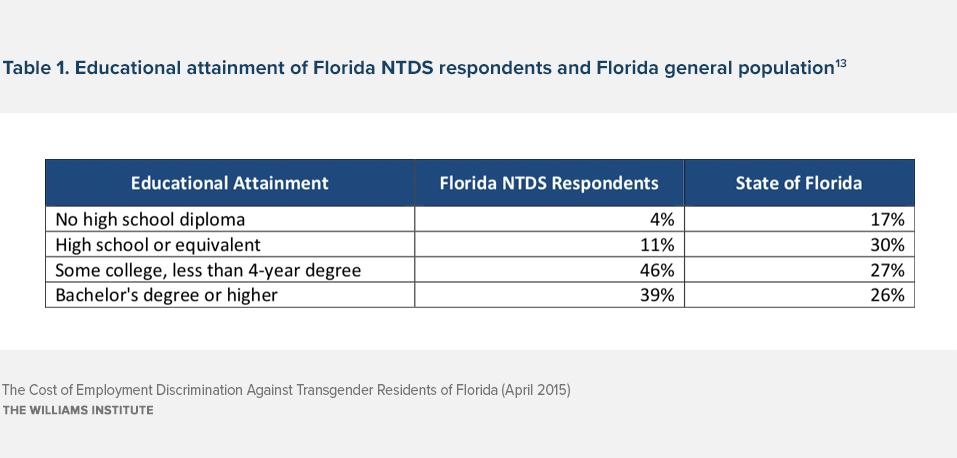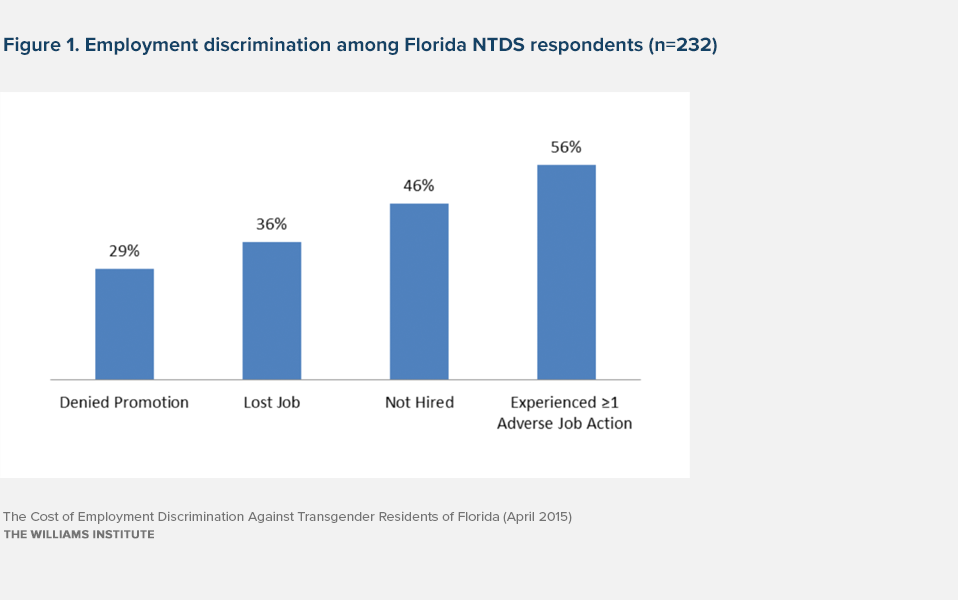Introduction and Summary
Transgender Floridians have reported experiencing discrimination based on gender identity in a number of areas, including employment. The National Transgender Discrimination Survey (NTDS) found that transgender people experience employment discrimination throughout the country. However, NTDS respondents in Florida reported a higher prevalence of employment discrimination than nationally. In Florida, 36 percent of respondents reported losing a job, 46 percent reported not being hired, and 29 percent reported being denied a promotion due to gender identity discrimination.
Currently, in Florida, there are no explicit state-wide statutory protections from gender identity discrimination. An estimated 46,600 adult Floridians identify as transgender. While a portion of these individuals live in municipalities that explicitly prohibit gender identity discrimination, 21,900 transgender adults do not. These individuals stand to benefit from a state-wide statute.
When considering whether to enact a state-wide statute, policy-makers may consider the potential fiscal impact of such a statute. To the extent that enacting a statute prohibiting discrimination will reduce or eliminate discrimination against transgender people, the state may realize cost savings. While there are a number of state-funded programs that could see cost savings from reducing or eliminating anti-transgender discrimination, this study looks at one particular program: Medicaid. We estimate that employment discrimination against transgender residents of Florida costs the state approximately $570,000 annually in Medicaid expenditures.
Estimating the Transgender Adult Population of Florida
The U.S. Census Bureau estimates, from data derived in the 2013 American Community Survey, that Florida had a population of approximately 15,524,971 adult residents in 2013. It is estimated that 0.3 percent of adults throughout the United States identify as transgender. Applying this percentage to the state of Florida, we find that approximately 46,600 adult Florida residents would identify as transgender.
Scope of Current Anti-Discrimination Ordinances in Florida
While the state of Florida does not explicitly prohibit discrimination based on gender identity by statute, 10 counties and 14 cities in the state have enacted local ordinances that prohibit such discrimination in public and private employment. Based upon population estimates from the U.S. Census Bureau’s American Community Survey, these 24 localities are home to 53 percent of Florida’s adult residents. Assuming that transgender adults generally live in the same places as non-transgender adults, we estimate that 47 percent of Florida’s transgender population (about 21,900 adults) lives in areas without laws that expressly prohibit discrimination based on gender identity. Because local non-discrimination ordinances may reduce incidents of discrimination within the covered jurisdictions, this study will only consider the 21,900 residents who are not covered by local ordinances that expressly prohibit discrimination based on gender identity.
Employment Discrimination against Transgender Floridians
In the largest study of discrimination against transgender individuals to date, the NTDS revealed that transgender people report mistreatment in the workplace. In addition to the obstacles that transgender individuals reported in education, health care, family lives, and communities, transgender respondents described persistent barriers in acquiring and maintaining employment as a result of discrimination.
Twelve percent of NTDS respondents reported an annual household income of $10,000 or less compared to 4 percent of all Florida residents. Yet, several studies, including the NTDS, have consistently found higher educational attainment among transgender individuals than the general population. Data in Table 1 below show that NTDS respondents from Florida were more likely to have attended college and also more likely to have completed college than Florida residents overall. Higher educational attainment typically results in higher incomes, but in this case, transgender NTDS respondents have lower income even while having higher educational attainment. The observed income disparity is likely due, at least in part, to gender identity discrimination in employment.

Florida general population estimates drawn from the U.S. Census Bureau, Current Population Survey, Annual Social & Economic Supplement, 2009
Applying prevalence estimates from the NTDS to the adult transgender population in the state of Florida that is not covered by local nondiscrimination ordinances, we estimate that 7,900 (36%) residents have lost a job, 10,100 (46%) have been denied a job, and 6,300 (29%) have been denied a promotion because of their gender identity. In total, 12,300 (56%) transgender residents have experienced at least one adverse action in the workplace, including being fired, not hired, or denied a promotion because of their gender identity (see Figure 1).
Estimating the Cost of Employment Discrimination
Loss of employment can often result in lost wages and health insurance for the individual, who may then need to enroll in Medicaid. These individuals may also face housing instability because of unemployment, which could result in costs to the state if these individuals then participate in homelessness prevention programs, access public housing, or utilize other state-supported programs. Reduced purchasing power due to lost wages has the potential to affect state and local sales tax revenues as well.
In this study, we focus on one specific cost of employment discrimination: state Medicaid expenditures that result from individuals losing their employer-provided coverage due to employment discrimination. We estimate that alone this costs the state approximately $570,000 annually.
Public Assistance Expenditures
Individuals may face financial insecurity at the loss of a job. Losing income and health insurance coverage as a result of job loss may negatively impact the financial stability of individuals and their families. Individuals and families in this situation may need to enroll in state- and federally-sponsored cash assistance and health care coverage programs. In Florida, these programs include Medicaid, Supplemental Security Income (SSI), and Temporary Assistance for Needy Families (TANF), among other programs.
In 2013, Medicaid provided coverage to over 3.3 million Floridians. We assume that this figure includes a number of transgender Floridians who have enrolled in Medicaid as a result of losing employer-based coverage due to anti-transgender employment discrimination.
Among NTDS respondents from Florida who had lost a job due to anti-transgender discrimination, 6 percent reported that they received health insurance coverage through Medicaid. Of the respondents who had not lost a job due to anti-transgender discrimination, none reported having coverage through Medicaid. We assume the difference in Medicaid enrollment between these two groups represents the elevated need for Medicaid coverage as a result of employment discrimination. Based on the number of transgender Floridians living without protection from employment discrimination, we estimate that 473 transgender Floridians are covered by Medicaid as a result of anti-transgender employment discrimination. In the absence of employment discrimination, we assume these 473 individuals would not have enrolled in Medicaid. In Florida, the average state expenditure in 2011 per adult Medicaid enrollee was $1,207. Therefore, the enrollment of these 473 individuals costs the state approximately $570,000 annually.
Conclusion
Ensuring employment protection for transgender Floridians can be viewed as a cost-saving measure. There are a variety of costs that can accrue to the state when transgender individuals face discrimination in the workplace. The costs that result from elevated enrollment in Medicaid represent only one such cost. By eliminating discrimination in the workplace for Florida’s transgender residents, the state could save more than half of a million dollars each year in state Medicaid expenditures alone.
Download the brief

